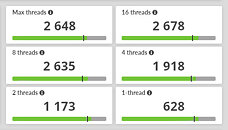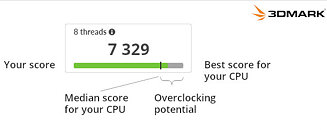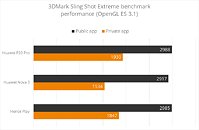Apr 13th, 2025 15:10 EDT
change timezone
Latest GPU Drivers
New Forum Posts
- Optical Disc Drive owners club (198)
- How to relubricate a fan and/or service a troublesome/noisy fan. (217)
- SK hynix A-Die (Overclocking thread) only for RYZEN AM5 users (30)
- Regarding fan noise (5)
- RX 9000 series GPU Owners Club (309)
- Overclocking Micron F-die RAM (0)
- What are you playing? (23376)
- What is going to be your next tech upgrade? just curious :) (37)
- best ram to buy for my usage and system specs? (18)
- Dell Latitude 5420 - i7 1185G7 (2)
Popular Reviews
- Thermaltake TR100 Review
- The Last Of Us Part 2 Performance Benchmark Review - 30 GPUs Compared
- TerraMaster F8 SSD Plus Review - Compact and quiet
- ASUS GeForce RTX 5080 TUF OC Review
- Zotac GeForce RTX 5070 Ti Amp Extreme Review
- ASRock Z890 Taichi OCF Review
- Sapphire Radeon RX 9070 XT Pulse Review
- Sapphire Radeon RX 9070 XT Nitro+ Review - Beating NVIDIA
- Upcoming Hardware Launches 2025 (Updated Apr 2025)
- AMD Ryzen 7 9800X3D Review - The Best Gaming Processor
Controversial News Posts
- NVIDIA GeForce RTX 5060 Ti 16 GB SKU Likely Launching at $499, According to Supply Chain Leak (181)
- MSI Doesn't Plan Radeon RX 9000 Series GPUs, Skips AMD RDNA 4 Generation Entirely (146)
- Microsoft Introduces Copilot for Gaming (124)
- NVIDIA Sends MSRP Numbers to Partners: GeForce RTX 5060 Ti 8 GB at $379, RTX 5060 Ti 16 GB at $429 (123)
- Nintendo Confirms That Switch 2 Joy-Cons Will Not Utilize Hall Effect Stick Technology (105)
- Over 200,000 Sold Radeon RX 9070 and RX 9070 XT GPUs? AMD Says No Number was Given (100)
- Nintendo Switch 2 Launches June 5 at $449.99 with New Hardware and Games (99)
- NVIDIA PhysX and Flow Made Fully Open-Source (77)
News Posts matching #UL
Return to Keyword Browsing
LG Display Achieves UL Solutions Eyesafe Verification for OLED Television and Monitors
UL Solutions today announced that LG Display's organic light-emitting diode (OLED) televisions and monitors have achieved UL Solutions Eyesafe Verification, a global first, confirming the accuracy and reliability of LG Display's marketing claims that their OLED models effectively reduce circadian-stimulating blue light emissions.
"UL Solutions' Marketing Claim Verification process is designed to give consumers confidence in product claims," said Todd Denison, senior vice president of Global Regions at UL Solutions. "By validating advertising and promotional statements, UL Solutions helps consumers distinguish between verified facts and unsubstantiated claims. This objective, science-driven assessment process that uses Eyesafe requirements is crucial in today's market, where consumers are increasingly concerned about the potential health effects of prolonged screen time."
"UL Solutions' Marketing Claim Verification process is designed to give consumers confidence in product claims," said Todd Denison, senior vice president of Global Regions at UL Solutions. "By validating advertising and promotional statements, UL Solutions helps consumers distinguish between verified facts and unsubstantiated claims. This objective, science-driven assessment process that uses Eyesafe requirements is crucial in today's market, where consumers are increasingly concerned about the potential health effects of prolonged screen time."

UL Announces the Procyon AI Image Generation Benchmark Based on Stable Diffusion
We're excited to announce we're expanding our AI Inference benchmark offerings with the UL Procyon AI Image Generation Benchmark, coming Monday, 25th March. AI has the potential to be one of the most significant new technologies hitting the mainstream this decade, and many industry leaders are competing to deliver the best AI Inference performance through their hardware. Last year, we launched the first of our Procyon AI Inference Benchmarks for Windows, which measured AI Inference performance with a workload using Computer Vision.
The upcoming UL Procyon AI Image Generation Benchmark provides a consistent, accurate and understandable workload for measuring the AI performance of high-end hardware, built with input from members of the industry to ensure fair and comparable results across all supported hardware.
The upcoming UL Procyon AI Image Generation Benchmark provides a consistent, accurate and understandable workload for measuring the AI performance of high-end hardware, built with input from members of the industry to ensure fair and comparable results across all supported hardware.

UL Solutions Previews Upcoming 3DMark Steel Nomad Benchmark
Thank you to the 3DMark community - the gamers, overclockers, hardware reviewers, tech-heads and those in the industry using our benchmarks, who have joined us in discovering what the cutting edge of PC hardware can do over this last quarter of a century. Looking back, it's amazing how far graphics have come, and we're very excited to see what the next 25 years bring.
After looking back, it's time to share a sneak peek of what's coming next. Here are some preview screenshots for 3DMark Steel Nomad, our successor to 3DMark Time Spy. It's been more than seven years since we launched Time Spy, and after more than 42 million submitted results, we think it's time for a new heavy non-ray tracing benchmark. Steel Nomad will be our most demanding non-ray tracing benchmark and will not only support Windows using DirectX 12, but also macOS and iOS using Metal, Android using Vulkan, and Linux using Vulkan for Enterprise and reviewers. To celebrate 3DMark's 25th year, the scene will feature some callbacks to many of our previous benchmarks. We hope you have fun finding them all!
After looking back, it's time to share a sneak peek of what's coming next. Here are some preview screenshots for 3DMark Steel Nomad, our successor to 3DMark Time Spy. It's been more than seven years since we launched Time Spy, and after more than 42 million submitted results, we think it's time for a new heavy non-ray tracing benchmark. Steel Nomad will be our most demanding non-ray tracing benchmark and will not only support Windows using DirectX 12, but also macOS and iOS using Metal, Android using Vulkan, and Linux using Vulkan for Enterprise and reviewers. To celebrate 3DMark's 25th year, the scene will feature some callbacks to many of our previous benchmarks. We hope you have fun finding them all!

UL Solutions Launches 3DMark Solar Bay, New Cross-Platform Ray Tracing Benchmark
We're excited to announce the launch of 3DMark Solar Bay, a new cross-platform benchmark for testing ray traced graphics performance on Windows PCs and high-end Android devices. This benchmark measures games-related graphics performance by rendering a demanding, ray-traced scene in real time. Solar Bay is available now for Android on the Google Play Store and for Windows on Steam, Epic Games or directly from UL Solutions.
Compare ray tracing performance across platforms
Ray tracing is the showcase technology for Solar Bay, simulating real-time reflections. Compared to traditional rasterization, ray-traced scenes produce far more realistic lighting. While dedicated desktop and laptop graphics processing units (GPUs) have supported ray tracing for several years, it's only recently that integrated GPUs and Android devices have been capable of running real-time ray-traced games at frame rates acceptable to gamers.
Compare ray tracing performance across platforms
Ray tracing is the showcase technology for Solar Bay, simulating real-time reflections. Compared to traditional rasterization, ray-traced scenes produce far more realistic lighting. While dedicated desktop and laptop graphics processing units (GPUs) have supported ray tracing for several years, it's only recently that integrated GPUs and Android devices have been capable of running real-time ray-traced games at frame rates acceptable to gamers.

3DMark Gets AMD FidelityFX Super Resolution 2 (FSR 2) Feature Test
UL Benchmarks today released an update to 3DMark that adds a Feature Test for AMD FidelityFX Super Resolution 2 (FSR 2), the company's popular upscaling-based performance enhancement. This was long overdue, as 3DMark has had a Feature Test for DLSS for years now; and as of October 2022, it even got one for Intel XeSS. The new FSR 2 Feature Test uses a scene from the Speed Way DirectX 12 Ultimate benchmark, where it compares fine details of a vehicle and a technic droid between native resolution with TAA and FSR 2, and highlights the performance uplift. To use the feature test, you'll need any GPU that supports DirectX 12 and FSR 2 (that covers AMD, NVIDIA, and Intel Arc). For owners of 3DMark who purchased it before October 12, 2022, they'll need to purchase the Speed Way upgrade to unlock the AMD FSR feature test.

UL Benchmarks Launches 3DMark Speedway DirectX 12 Ultimate Benchmark
UL Solutions is excited to announce that our new DirectX 12 Ultimate Benchmark 3DMark Speed Way is now available to download and buy on Steam and on the UL Solutions website. 3DMark Speed Way is sponsored by Lenovo Legion. Developed with input from AMD, Intel, NVIDIA, and other leading technology companies, Speed Way is an ideal benchmark for comparing the DirectX 12 Ultimate performance of the latest graphics cards.
DirectX 12 Ultimate is the next-generation application programming interface (API) for gaming graphics. It adds powerful new capabilities to DirectX 12, helping game developers improve visual quality, boost frame rates, reduce loading times and create vast, detailed worlds. 3DMark Speed Way's engine demonstrates what the latest DirectX API brings to ray-traced gaming, using DirectX Raytracing tier 1.1 for real-time global illumination and real-time ray-traced reflections, coupled with new performance optimizations like mesh shaders.
DirectX 12 Ultimate is the next-generation application programming interface (API) for gaming graphics. It adds powerful new capabilities to DirectX 12, helping game developers improve visual quality, boost frame rates, reduce loading times and create vast, detailed worlds. 3DMark Speed Way's engine demonstrates what the latest DirectX API brings to ray-traced gaming, using DirectX Raytracing tier 1.1 for real-time global illumination and real-time ray-traced reflections, coupled with new performance optimizations like mesh shaders.

3DMark Speed Way DirectX 12 Ultimate Benchmark is Launching on October 12
3DMark Speed Way is a new GPU benchmark that showcases the graphics technology that will power the next generation of gaming experiences. We're excited to announce Speed Way, sponsored by Lenovo Legion, is releasing on October 12. Our team has been working hard to get Speed Way ready for you to use benchmarking, stress testing, and comparing the new PC hardware coming this fall.
From October 12 onward, Speed Way will be included in the price when you buy 3DMark from Steam or our own online store. Since we released Time Spy in 2016, 3DMark users have enjoyed many free updates, including Time Spy Extreme, the 3DMark CPU Profile, 3DMark Wild Life, and multiple tests demonstrating new DirectX features. With the addition of Speed Way, the price of 3DMark on Steam and 3DMark Advanced Edition will go up from $29.99 to $34.99.
From October 12 onward, Speed Way will be included in the price when you buy 3DMark from Steam or our own online store. Since we released Time Spy in 2016, 3DMark users have enjoyed many free updates, including Time Spy Extreme, the 3DMark CPU Profile, 3DMark Wild Life, and multiple tests demonstrating new DirectX features. With the addition of Speed Way, the price of 3DMark on Steam and 3DMark Advanced Edition will go up from $29.99 to $34.99.

Razer Announces World's First ECOLOGO-Certified Gaming Mice
Razer, the leading global lifestyle brand for gamers, celebrates World Environment Day, by announcing that the Basilisk V3 and the DeathAdder Essential, are the first gaming mice to achieve an ECOLOGO certification by global safety science leader, UL. The mice have passed UL2710, the Outline of Investigation for Sustainability for Portable Electronics, which certifies them as sustainable products.
Razer has undergone the certification process to assure its fans that its best-selling mice meet strict environmental performance industry standards. The ECOLOGO Mark achievement means that the products have been evaluated by an independent scientific third-party and are aligned with Razer's goals to be transparent with its community. Razer having the first ECOLOGO-certified gaming mice is a tribute to the brand's commitment to making greener products, which is also a major pillar in its ten-year sustainability plan #GoGreenWithRazer.
Razer has undergone the certification process to assure its fans that its best-selling mice meet strict environmental performance industry standards. The ECOLOGO Mark achievement means that the products have been evaluated by an independent scientific third-party and are aligned with Razer's goals to be transparent with its community. Razer having the first ECOLOGO-certified gaming mice is a tribute to the brand's commitment to making greener products, which is also a major pillar in its ten-year sustainability plan #GoGreenWithRazer.

UL Benchmarks Unveils the 3DMark Speed Way Benchmark
UL Benchmarks is ready with a new graphics benchmark for enthusiast-segment graphics cards, to show you whether your present hardware can deal with games coming out several years from now. The new "Speed Way" benchmark utilizes all of the features that make up the DirectX 12 Ultimate API, which include real-time ray tracing, mesh shaders, variable-rate shading, and sampler feedback. It uses ray tracing for reflections, lighting, and global-illumination.
Until now, the various DirectX 12 Ultimate features were only part of 3DMark as API feature-tests. The older "Port Royal" benchmark, which released around the time of NVIDIA "Turing," is the company's first benchmark with real-time ray tracing, although it doesn't use all DirectX 12 Ultimate features. With each new benchmark, the makers of 3DMark collaborate with a new gaming brand sponsor. For Speed Way, it's Legion, a brand of pre-built gaming notebooks and desktops by Lenovo. UL Benchmarks didn't reveal an exact release date except "later this year."
Until now, the various DirectX 12 Ultimate features were only part of 3DMark as API feature-tests. The older "Port Royal" benchmark, which released around the time of NVIDIA "Turing," is the company's first benchmark with real-time ray tracing, although it doesn't use all DirectX 12 Ultimate features. With each new benchmark, the makers of 3DMark collaborate with a new gaming brand sponsor. For Speed Way, it's Legion, a brand of pre-built gaming notebooks and desktops by Lenovo. UL Benchmarks didn't reveal an exact release date except "later this year."

Samsung Electronics Expands its "Green Chip" Line-Up
Samsung Electronics Co., Ltd., a world leader in advanced semiconductor technology, today announced that five of its memory products achieved global recognition for successfully reducing its carbon emission, while 20 additional memory products received carbon footprint certification. Samsung's automotive LED packages also had their carbon footprint verification, a first in the industry for automotive LED packages, further expanding Samsung's portfolio of eco-conscious "green chips".
"It is exciting to see our environmentally sustainable efforts receiving global acknowledgements," said Seong-dai Jang, Senior Vice President and Head of DS Corporate Sustainability Management Office at Samsung Electronics. "We will continue our path towards a sustainable future with 'greener' chips enabled by Samsung's cutting-edge technology."
"It is exciting to see our environmentally sustainable efforts receiving global acknowledgements," said Seong-dai Jang, Senior Vice President and Head of DS Corporate Sustainability Management Office at Samsung Electronics. "We will continue our path towards a sustainable future with 'greener' chips enabled by Samsung's cutting-edge technology."

3DMark Updated with New CPU Benchmarks for Gamers and Overclockers
UL Benchmarks is expanding 3DMark today by adding a set of dedicated CPU benchmarks. The 3DMark CPU Profile introduces a new approach to CPU benchmarking that shows how CPU performance scales with the number of cores and threads used. The new CPU Profile benchmark tests are available now in 3DMark Advanced Edition and 3DMark Professional Edition.
The 3DMark CPU Profile introduces a new approach to CPU benchmarking. Instead of producing a single number, the 3DMark CPU Profile shows how CPU performance scales and changes with the number of cores and threads used. The CPU Profile has six tests, each of which uses a different number of threads. The benchmark starts by using all available threads. It then repeats using 16 threads, 8 threads, 4 threads, 2 threads, and ends with a single-threaded test. These six tests help you benchmark and compare CPU performance for a range of threading levels. They also provide a better way to compare different CPU models by looking at the results from thread levels they have in common.
The 3DMark CPU Profile introduces a new approach to CPU benchmarking. Instead of producing a single number, the 3DMark CPU Profile shows how CPU performance scales and changes with the number of cores and threads used. The CPU Profile has six tests, each of which uses a different number of threads. The benchmark starts by using all available threads. It then repeats using 16 threads, 8 threads, 4 threads, 2 threads, and ends with a single-threaded test. These six tests help you benchmark and compare CPU performance for a range of threading levels. They also provide a better way to compare different CPU models by looking at the results from thread levels they have in common.

UL Benchmarks Announces End of Support for 3DMark 11, PCMark 7, and some 3DMark Benchmarks
You may have heard that Microsoft will end support for Windows 7 on January 14, 2020. Benchmarks also have a natural lifespan that ends when they no longer provide meaningful results on modern hardware. When old benchmarks are used with new hardware, the results can be skewed or limited in ways that reduce their accuracy and relevance.
Today, we're announcing that, from January 14, 2020, we will no longer offer updates or support for 3DMark 11, PCMark 7, Powermark, 3DMark Cloud Gate, and 3DMark Ice Storm benchmarks. These benchmarks, all of which were released between 2011 and 2013, no longer provide useful, comparable results with modern hardware. In every case, there is a newer and more relevant benchmark test that you should use instead.
Today, we're announcing that, from January 14, 2020, we will no longer offer updates or support for 3DMark 11, PCMark 7, Powermark, 3DMark Cloud Gate, and 3DMark Ice Storm benchmarks. These benchmarks, all of which were released between 2011 and 2013, no longer provide useful, comparable results with modern hardware. In every case, there is a newer and more relevant benchmark test that you should use instead.

3DMark Introduces Variable Rate Shading Benchmark
3DMark today announced they've introduced a new benchmarking feature. Specifically developed to test Variable Rate Shading (VRS) performance and image quality differences, the new feature allows users to actually visualize the performance and image quality differences associated with more aggressive (or less aggressive) VRS settings. The algorithm is a smart one - it aims to reduce the number of pixel shader operations on surfaces where detail isn't as important (such as frame edges, fast-moving objects, darkened areas, etc) so as to improve performance and shave some precious milliseconds in the deployment of each frame.
To run this test, you will need Windows 10 version 1903 or later and a DirectX 12 GPU that supports Tier 1 VRS and the "AdditionalShadingRatesSupported" capability, such as an NVIDIA Turing-based GPU or an Intel Ice Lake CPU. The VRS feature test is available now as a free update for 3DMark Advanced Edition, or from now until September 2, 3DMark is 75% off when you buy it from Steam or the UL benchmarks website.
To run this test, you will need Windows 10 version 1903 or later and a DirectX 12 GPU that supports Tier 1 VRS and the "AdditionalShadingRatesSupported" capability, such as an NVIDIA Turing-based GPU or an Intel Ice Lake CPU. The VRS feature test is available now as a free update for 3DMark Advanced Edition, or from now until September 2, 3DMark is 75% off when you buy it from Steam or the UL benchmarks website.

UL Releases PCI Express Feature Test For 3DMark Ahead of PCIe 4.0 Hardware
With PCI-Express 4.0 graphics cards and motherboards soon to arrive, UL has released their PCI Express feature test for 3DMark. This latest addition has been designed to verify the bandwidth available to the GPU over a computer's PCI Express interface. To accomplish this, the test will make bandwidth the limiting factor for performance and does so by uploading a large amount of vertex and texture data to the GPU for each frame. The end goal is to transfer enough data over the PCIe 4.0 interface to thoroughly saturate it. Once the test is complete, the end result will be a look at the average bandwidth achieved during the test.
UL Corporation Announces Two New Benchmarks Coming to PCMark 10
UL Corporation today announces that two new benchmark tests that will soon be coming to PCMark 10. The first is our eagerly awaited PCMark 10 battery life benchmark. The second is a new benchmark test based on Microsoft Office applications.
PCMark 10 Battery Life benchmark
Battery life is one of the most important criteria for choosing a laptop, but consumers and businesses alike find it hard to compare systems fairly. The challenge, of course, is that battery life depends on how the device is used. Unfortunately, manufacturers' claims are often based on unrealistic scenarios that don't reflect typical use. Figures for practical, day-to-day battery life, which are usually much lower, are rarely available.
PCMark 10 Battery Life benchmark
Battery life is one of the most important criteria for choosing a laptop, but consumers and businesses alike find it hard to compare systems fairly. The challenge, of course, is that battery life depends on how the device is used. Unfortunately, manufacturers' claims are often based on unrealistic scenarios that don't reflect typical use. Figures for practical, day-to-day battery life, which are usually much lower, are rarely available.

FSP Introduces Modular Flex ATX PSU with Mechanical Design
With the current growth of the industrial control equipment, industrial computers, surveillance system, POS system, gaming machines, edge computing, and IoT device field markets, the needs for Flex ATX specification power supplies are also increasing. FSP has great advantages in the Flex ATX power supply product markets; not only does it have the most complete Flex ATX products (with over 30 models in this form factor), most of these products also complies with the 80PLUS requirement, offering a variety of efficiency ratings ranging from bronze to platinum.
FSP's Flex ATX models are available in standard direct output and modular cable configurations, and include the most modular models selections in the industry. The modular design can improve the ease of use of power supply. Customers can configure their power cables according to the system needs, and if the power supply is damaged in the future, they only need to replace the power supply. The special plug-in design for cables and jacks improves the convenience of replacement. The design of full modular connectors also allows users to quickly disassemble cables, locate issues and save debugging time whenever the system experiences problems.
FSP's Flex ATX models are available in standard direct output and modular cable configurations, and include the most modular models selections in the industry. The modular design can improve the ease of use of power supply. Customers can configure their power cables according to the system needs, and if the power supply is damaged in the future, they only need to replace the power supply. The special plug-in design for cables and jacks improves the convenience of replacement. The design of full modular connectors also allows users to quickly disassemble cables, locate issues and save debugging time whenever the system experiences problems.

UL Benchmarks Kicks Huawei Devices from its Database over Cheating
UL Benchmarks de-listed several popular Huawei devices from its database over proof of cheating in its benchmarks. Over the month, it was found that several of Huawei's devices, such as P20 Pro, Nova 3, and Play; overclocked their SoCs while ignoring all power and thermal limits, to achieve high benchmark scores, when it detected that a popular benchmark such as 3DMark, was being run. To bust this, UL Benchmarks tested the three devices with "cloaked" benchmarks, or "private benchmarks" as they call it. These apps are identical in almost every way to 3DMark, but lack the identification or branding that lets Huawei devices know when to overclock themselves to cheat the test.
The results were startling. When the devices have no clue that a popular benchmark is being run (or if has no way of telling that 3DMark is being run), it chugs along at its "normal" speed, which is 35% to 36% lower. The rules that bind device manufacturers from advertising UL's 3DMark scores explicitly state that the device must not detect the app and optimize its hardware on the fly to ace the test. Huawei responded to UL by stating that it will unlock a new "performance mode" to users that lets them elevate their SoCs to the same high clocks for any application.
The results were startling. When the devices have no clue that a popular benchmark is being run (or if has no way of telling that 3DMark is being run), it chugs along at its "normal" speed, which is 35% to 36% lower. The rules that bind device manufacturers from advertising UL's 3DMark scores explicitly state that the device must not detect the app and optimize its hardware on the fly to ace the test. Huawei responded to UL by stating that it will unlock a new "performance mode" to users that lets them elevate their SoCs to the same high clocks for any application.
UL's Raytracing Benchmark Not Based on Time Spy, Completely New Development
After we've covered news of UL's (previously known as 3D Mark) move to include a raytracing benchmark mode on Time Spy, the company has contacted us and other members of the press to clarify their message and intentions. As it stands, the company will not be updating their Time Spy testing suite with Raytracing technologies. Part of the reason is that this would need an immense rewrite of the benchmark itself, which would be counterproductive - and this leads to the rest of the reason why it's not so: such a significant change would invalidate previous results that didn't have the Raytracing mode activated.
As such, UL has elected to develop a totally new benchmark, built from the ground up to use Microsoft's DirectX Raytracing (DXR). This new benchmark will be added to the 3D Mark app as an update. The new test will produce its own benchmarking scores, very much like Fire Strike and Time Spy did, and will provide users with yet another ladder to climb on their way to the top of the benchmarking scene. Other details are scarce - which makes sense. But the test should still be available on or around the time of NVIDIA's 20-series launch, come September 20th.
As such, UL has elected to develop a totally new benchmark, built from the ground up to use Microsoft's DirectX Raytracing (DXR). This new benchmark will be added to the 3D Mark app as an update. The new test will produce its own benchmarking scores, very much like Fire Strike and Time Spy did, and will provide users with yet another ladder to climb on their way to the top of the benchmarking scene. Other details are scarce - which makes sense. But the test should still be available on or around the time of NVIDIA's 20-series launch, come September 20th.
3D Mark's Time Spy With Raytracing to be Launched by the End of September
(Update: UL has come forward to clarify the way they're integrating Raytracing into their benchmarking suite. You can read the follow-up article here.)
UL (who acquired and is in the process of changing 3D Mark's image to that of its own) has revealed that the new, raytracing-supporting version of their Time Spy high performance and high quality benchmark will be arriving by the end of September.
The new version of the benchmark will be released around the launch of Microsoft's next version of its Windows 10 Operating System, codenamed Redstone 5, and thus will fall in some time after NVIDIA's RTX 20-series launch on September 20th. Here's hoping it will be available in time for comparative reviews on NVIDIA's new family of products, and that some light can be shed on the new series' framerates delivery, and not just their GigaRays/sec capabilities.
UL (who acquired and is in the process of changing 3D Mark's image to that of its own) has revealed that the new, raytracing-supporting version of their Time Spy high performance and high quality benchmark will be arriving by the end of September.
The new version of the benchmark will be released around the launch of Microsoft's next version of its Windows 10 Operating System, codenamed Redstone 5, and thus will fall in some time after NVIDIA's RTX 20-series launch on September 20th. Here's hoping it will be available in time for comparative reviews on NVIDIA's new family of products, and that some light can be shed on the new series' framerates delivery, and not just their GigaRays/sec capabilities.
Apr 13th, 2025 15:10 EDT
change timezone
Latest GPU Drivers
New Forum Posts
- Optical Disc Drive owners club (198)
- How to relubricate a fan and/or service a troublesome/noisy fan. (217)
- SK hynix A-Die (Overclocking thread) only for RYZEN AM5 users (30)
- Regarding fan noise (5)
- RX 9000 series GPU Owners Club (309)
- Overclocking Micron F-die RAM (0)
- What are you playing? (23376)
- What is going to be your next tech upgrade? just curious :) (37)
- best ram to buy for my usage and system specs? (18)
- Dell Latitude 5420 - i7 1185G7 (2)
Popular Reviews
- Thermaltake TR100 Review
- The Last Of Us Part 2 Performance Benchmark Review - 30 GPUs Compared
- TerraMaster F8 SSD Plus Review - Compact and quiet
- ASUS GeForce RTX 5080 TUF OC Review
- Zotac GeForce RTX 5070 Ti Amp Extreme Review
- ASRock Z890 Taichi OCF Review
- Sapphire Radeon RX 9070 XT Pulse Review
- Sapphire Radeon RX 9070 XT Nitro+ Review - Beating NVIDIA
- Upcoming Hardware Launches 2025 (Updated Apr 2025)
- AMD Ryzen 7 9800X3D Review - The Best Gaming Processor
Controversial News Posts
- NVIDIA GeForce RTX 5060 Ti 16 GB SKU Likely Launching at $499, According to Supply Chain Leak (181)
- MSI Doesn't Plan Radeon RX 9000 Series GPUs, Skips AMD RDNA 4 Generation Entirely (146)
- Microsoft Introduces Copilot for Gaming (124)
- NVIDIA Sends MSRP Numbers to Partners: GeForce RTX 5060 Ti 8 GB at $379, RTX 5060 Ti 16 GB at $429 (123)
- Nintendo Confirms That Switch 2 Joy-Cons Will Not Utilize Hall Effect Stick Technology (105)
- Over 200,000 Sold Radeon RX 9070 and RX 9070 XT GPUs? AMD Says No Number was Given (100)
- Nintendo Switch 2 Launches June 5 at $449.99 with New Hardware and Games (99)
- NVIDIA PhysX and Flow Made Fully Open-Source (77)

































